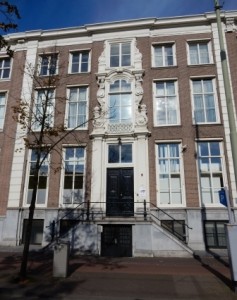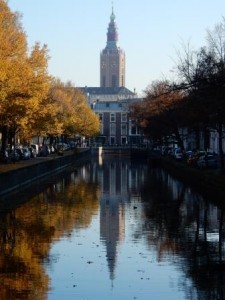I was born in a canal house, although not in The Hague. Although The Hague does have canals (grachten), this city is not known for its waterways.
 That used to be different and you become aware of this fact when you see certain street names. Take, for instance, the Prinsengracht. Apart from the tram tunnel this street is completely level, the actual “Princes’ Canal” having been filled in around 1900. Similarly, the beautiful houses in the Herengracht, once mirrored in the water of the “Patricians’ Canal”, find no reflections in today’s busy street. I could supply you with a long list of canals and harbours in The Hague that were filled in over the years. I won’t do so, because it is more interesting to focus on the question: why did this happen?
That used to be different and you become aware of this fact when you see certain street names. Take, for instance, the Prinsengracht. Apart from the tram tunnel this street is completely level, the actual “Princes’ Canal” having been filled in around 1900. Similarly, the beautiful houses in the Herengracht, once mirrored in the water of the “Patricians’ Canal”, find no reflections in today’s busy street. I could supply you with a long list of canals and harbours in The Hague that were filled in over the years. I won’t do so, because it is more interesting to focus on the question: why did this happen?
 So cholera was something to fear. Have you ever heard a Dutch person shouting at you: “Krijg de kleren !”?. And did you wonder what this meant and where the expression comes from? The original curse was “Krijg de kolere!” (Get the cholera!). Over time, it evolved into today’s “Krijg de kleren”. Other examples of cholera becoming part of the Dutch vocabulary are: “klerewijf” (bitch) and “klerezooi” (bloody mess).
In the mid-19th century it became clear that polluted water was the cause of cholera. So one of the main reasons to fill in the canal was hygiene. Filling wasn’t the only remedy. In 1874 The Hague got its fresh water supply: water was pumped from springs in the dune area and transported through pipes to the city center. 1893 saw the start of the building of the sewer system that was completed in 1910.
There have been several plans to restore canals in The Hague, but most have died due to lack of funding. However, in the Noordwal-Veenkade, water flows again above a modern, underground, fully automated car park.
I will tell you more about canals in The Hague and the origin of Dutch expressions during my city walks and bicycle tours.
So cholera was something to fear. Have you ever heard a Dutch person shouting at you: “Krijg de kleren !”?. And did you wonder what this meant and where the expression comes from? The original curse was “Krijg de kolere!” (Get the cholera!). Over time, it evolved into today’s “Krijg de kleren”. Other examples of cholera becoming part of the Dutch vocabulary are: “klerewijf” (bitch) and “klerezooi” (bloody mess).
In the mid-19th century it became clear that polluted water was the cause of cholera. So one of the main reasons to fill in the canal was hygiene. Filling wasn’t the only remedy. In 1874 The Hague got its fresh water supply: water was pumped from springs in the dune area and transported through pipes to the city center. 1893 saw the start of the building of the sewer system that was completed in 1910.
There have been several plans to restore canals in The Hague, but most have died due to lack of funding. However, in the Noordwal-Veenkade, water flows again above a modern, underground, fully automated car park.
I will tell you more about canals in The Hague and the origin of Dutch expressions during my city walks and bicycle tours.
 That used to be different and you become aware of this fact when you see certain street names. Take, for instance, the Prinsengracht. Apart from the tram tunnel this street is completely level, the actual “Princes’ Canal” having been filled in around 1900. Similarly, the beautiful houses in the Herengracht, once mirrored in the water of the “Patricians’ Canal”, find no reflections in today’s busy street. I could supply you with a long list of canals and harbours in The Hague that were filled in over the years. I won’t do so, because it is more interesting to focus on the question: why did this happen?
That used to be different and you become aware of this fact when you see certain street names. Take, for instance, the Prinsengracht. Apart from the tram tunnel this street is completely level, the actual “Princes’ Canal” having been filled in around 1900. Similarly, the beautiful houses in the Herengracht, once mirrored in the water of the “Patricians’ Canal”, find no reflections in today’s busy street. I could supply you with a long list of canals and harbours in The Hague that were filled in over the years. I won’t do so, because it is more interesting to focus on the question: why did this happen?
Population growth
I take you back to the second half of the 19th century, during which the population of The Hague increased from 70.000 to 200.000. There were no adequate facilities for this extensive population. The city’s canals had two rather conflicting functions: drinking water supply and open sewer. In the present day we worry about pollution from exhaust fumes and particulates. The 19th century inhabitants of The Hague had to cope with the stench of waste and faeces in the canals. In this environment, cholera bacteria thrived. Today it is hard to imagine, but in those days, cholera was a great threat to Western Europe. The disease arrived in Europe from Asia in 1830 and by 1832 it had reached The Netherlands. In that year hundreds of people died in The Hague. In the years 1849 and 1866 the city experienced two other major cholera epidemics.Krijg de kleren
 So cholera was something to fear. Have you ever heard a Dutch person shouting at you: “Krijg de kleren !”?. And did you wonder what this meant and where the expression comes from? The original curse was “Krijg de kolere!” (Get the cholera!). Over time, it evolved into today’s “Krijg de kleren”. Other examples of cholera becoming part of the Dutch vocabulary are: “klerewijf” (bitch) and “klerezooi” (bloody mess).
In the mid-19th century it became clear that polluted water was the cause of cholera. So one of the main reasons to fill in the canal was hygiene. Filling wasn’t the only remedy. In 1874 The Hague got its fresh water supply: water was pumped from springs in the dune area and transported through pipes to the city center. 1893 saw the start of the building of the sewer system that was completed in 1910.
There have been several plans to restore canals in The Hague, but most have died due to lack of funding. However, in the Noordwal-Veenkade, water flows again above a modern, underground, fully automated car park.
I will tell you more about canals in The Hague and the origin of Dutch expressions during my city walks and bicycle tours.
So cholera was something to fear. Have you ever heard a Dutch person shouting at you: “Krijg de kleren !”?. And did you wonder what this meant and where the expression comes from? The original curse was “Krijg de kolere!” (Get the cholera!). Over time, it evolved into today’s “Krijg de kleren”. Other examples of cholera becoming part of the Dutch vocabulary are: “klerewijf” (bitch) and “klerezooi” (bloody mess).
In the mid-19th century it became clear that polluted water was the cause of cholera. So one of the main reasons to fill in the canal was hygiene. Filling wasn’t the only remedy. In 1874 The Hague got its fresh water supply: water was pumped from springs in the dune area and transported through pipes to the city center. 1893 saw the start of the building of the sewer system that was completed in 1910.
There have been several plans to restore canals in The Hague, but most have died due to lack of funding. However, in the Noordwal-Veenkade, water flows again above a modern, underground, fully automated car park.
I will tell you more about canals in The Hague and the origin of Dutch expressions during my city walks and bicycle tours. 


1 thought on “Canals in The Hague”
Pingback: Haagse grachten: gedempt of niet gedempt - DenHaagDirect